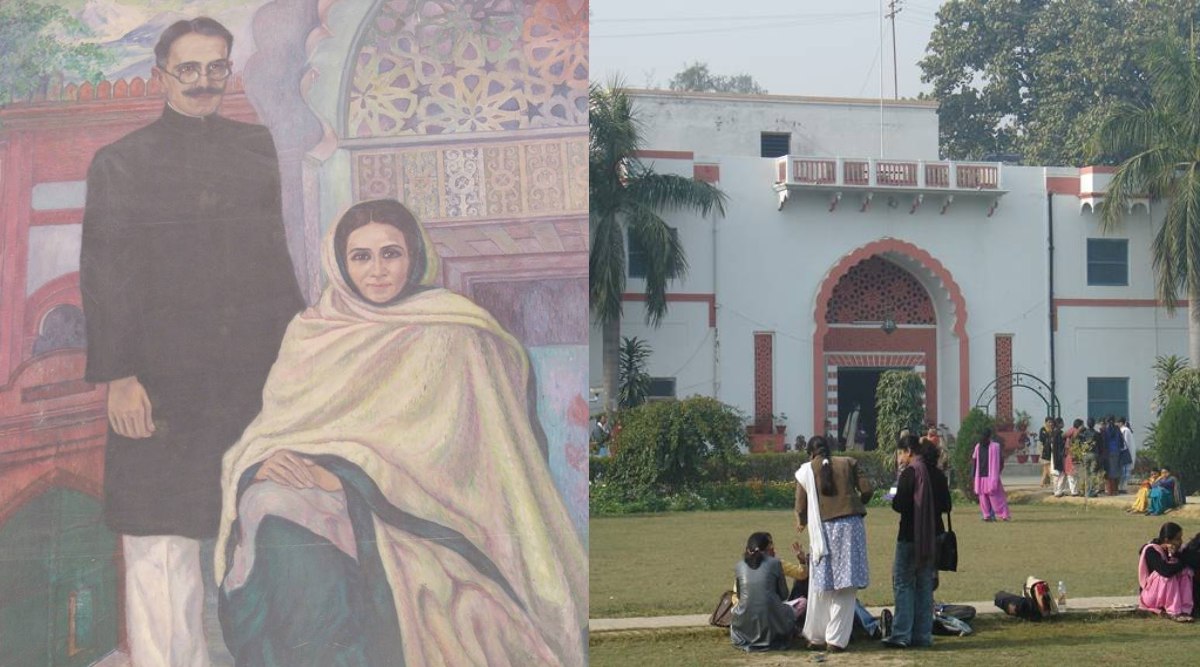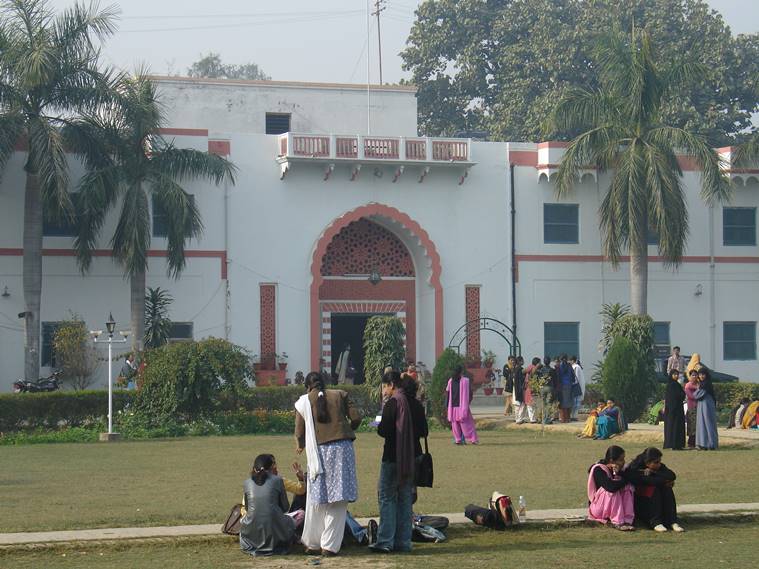The foundation day of AMU's Women's College is observed on February 2, which is the marriage anniversary of Sheikh Abdullah and Waheed Jahan. The day was chosen as Jahan shared the equal responsibility of teaching students, looking after the boarding students and vouching for the cause of female education in her speeches.
In 1875, when Sir Syed Ahmed Khan established Madrasatul Uloom in Aligarh to infuse the light of education in the Muslim community, nearly 1,000 kilometres away, Thakur Das was born in a Kashmiri Brahmin family at Bhantani village in Kashmir’s Poonch. Das became a pioneer of female education in British India while braving the conservative attitude within the Muslim community.
While the Madarsatul Uloom developed into Mohammedan Anglo Oriental College in 1877, and later into Aligarh Muslim University (1920), the institution that was founded by Thakur Das — who converted to Islam and became Sheikh Abdullah — became a full-fledged Women’s College and part of AMU.
Early life
Born nearly 145 years ago on June 21, 1874 into a Kashmiri Brahmin family, Thakur Das was the eldest of four brothers. As Persian was the court language and also the medium of literature, he studied it, but also gained knowledge of Sanskrit and English.
As destined, Das met Hakeem Maulvi Nooruddin — the chief physician to the Maharaja of Kashmir — which changed the course of his life. Maulvi Nooruddin often visited Poonch and after persuasion, Das joined him in Jammu to study medicine. After his primary education, Das left for Lahore in 1887 and took admission in Government High School. Maulvi Nooruddin remained in touch.
In Lahore, he attended the Mohammedan Educational Conference in 1888, and was much impressed. By 1890, Thakur Das had converted to Islam; he was now Abdullah. This meant that he ceased to have cordial relations with his family. A bigger role, however, had been carved out for him.
In 1891, when he took admission in Mohammedan Anglo Oriental College in Aligarh, Abdullah came in contact with Sir Syed Ahmed Khan, the founder of MAO College, and his companions. Abdullah completed his law and served as a librarian in the same college and later started his own practice at Aligarh court in 1900. In the meantime, Sir Syed died in 1898.
Female education
Convincing Muslims for female education was not easy. Strict observance of purdah, restricted and monitored movement of females, and them sharing space with other low caste girls were reasons enough to oppose their education.
Even the intelligentsia were not in support. “When his proposal was not well-received, Sheikh Abdullah started his school nearly five kilometres from MAO College in Aligarh. You can say that female education had apartheid status,” Dr Rahat Abrar, former director, Urdu Academy, AMU said.
In A Woman of Substance, the memoirs of Khurshid Mirza‘, written by Abdullah’s granddaughter Lubna Kazim (Mirza was his daughter), it is mentioned: “A meeting of the Muslim women was held to coincide with the 1905 Muslim Educational Conference in Aligarh. The exhibition was a huge success. There was a great deal of opposition, and permission to use one of the buildings on the campus was refused. At the last minute, an affluent Parsi friend of Sheikh Abdullah offered his house in Aligarh town (for the meeting).”
Sheikh Abdullah knew the nuances well. The organisation, Mohammedan Educational Conference, provided him with a platform to share his views. He was elected secretary of the Female Education Section of the All India Mohammedan Education Conference in Delhi in 1902. While earlier it was only men who debated the issue of women’s education, at his behest in 1903, women were allowed to listen to speeches at the annual conference, albeit with strict adherence to purdah. He toured across the country to propagate his idea and even published a monthly magazine Khatoon (1904) highlighting the importance of female education. This magazine proved to be a turning point as Muslim females across India — who had access to education and were privileged — started to write mails supporting the cause.
Sheikh Abdullah’s mission started gaining momentum, but he understood there should be involvement of Muslim females. It was his idea to start the craft exhibition of products made by Muslim women in 1905. The products featured embroidery work, paintings and other utilities. These exhibitions were well-attended and the sales brought some money for the cause.
In between, the much-needed impetus came from the Begum of Bhopal Sultan Jahan. She was the only Muslim woman ruler in India during that time, and a staunch supporter of female education. Sheikh Abdullah wrote her a letter, and in her reply on December 21, 1904, she assured a monthly stipend of Rs 100 from the day the school started functioning.
“Begum Sultan Jahan was a learned lady. She supported female education. She wrote several books and even a travelogue of her Haj Pilgrimage. Her support to Sheikh Abdullah provided the much-needed impetus and even a recognition of his efforts,” Professor Shafey Kidwai, Chairman, Department of Mass Communication, AMU said.
The Aligarh Girls School was set up in 1906 with only a few students, mostly from his family. It was a Herculean task to bring the students to school in a palanquin. By 1914, there was enough money to build a hostel.
After initial hiccups, the school became an intermediate college in 1926 and later, a part of AMU as Women’s College. The foundation stone of the college was laid by Lady Potter, the wife of the then Lieutenant Governor, on November 7, 1911. But, the foundation day is observed on February 2, which is the marriage anniversary of Sheikh Abdullah and Waheed Jahan.
The role of his wife is no less; she shared the equal responsibility of teaching students initially, looking after the boarding students and above all, vouching for the cause of female education by delivering speeches. She raised five daughters and one son with her husband, and it is said that Sheikh Abdullah’s crusade for women’s education would have been incomplete without Waheed Jahan.
Lubna Kazim, in another instance in her book, says: ‘”In one speech at a gathering of Muslim women in support of women’s education, she (Waheed Jahan) mentioned that in Turkey and Egypt women were being educated and this had been beneficial to their societies.” The speech was published in Khatoon, January 1906.
Khurshid Mirza (Khurshid Jahan) joined the film industry and worked with leading stars with the screen name ‘Renuka Devi’. Sheikh Abdullah did not bother about the brickbats on this matter either and never interfered in his daughter’s life. Before migrating to Pakistan, she had a successful career with films like Bhabhi, Ghulami, Sahara, Samrat Chandragupta, etc.
Dr Furqan Sambhali, Assistant Professor in Women’s College said Sheikh Abdullah’s daughters served as principals of the college. “Two of his daughters, Khatoon Jahan and Mumtaz Jahan, served as principals. Waheed Jahan was fondly addressed as ‘Ala Bi‘ and Sheikh Abdullah as ‘Papa Miyan‘ by the students,” he said.
Clearly a man ahead of his times, Sheikh Abdullah lived in Aligarh till his death in 1965. He was awarded the Padma Vibhushan in 1964. He also served as a member of the UP Legislative Council.
For more lifestyle news, follow us: Twitter: lifestyle_ie | Facebook: IE Lifestyle | Instagram: ie_lifestyle
Source: Read Full Article




